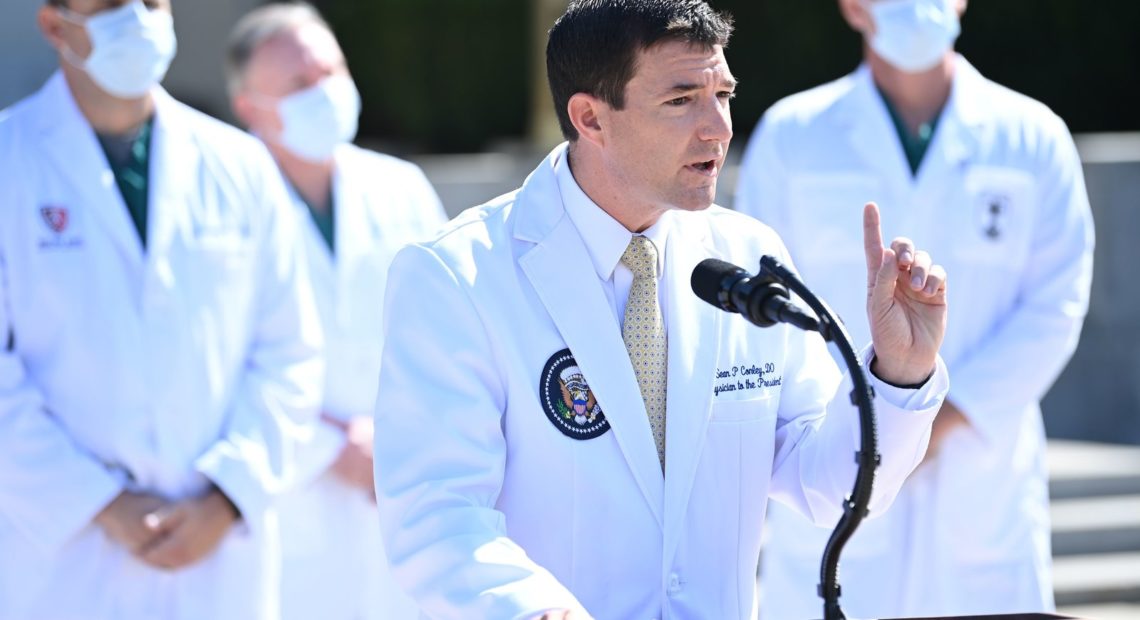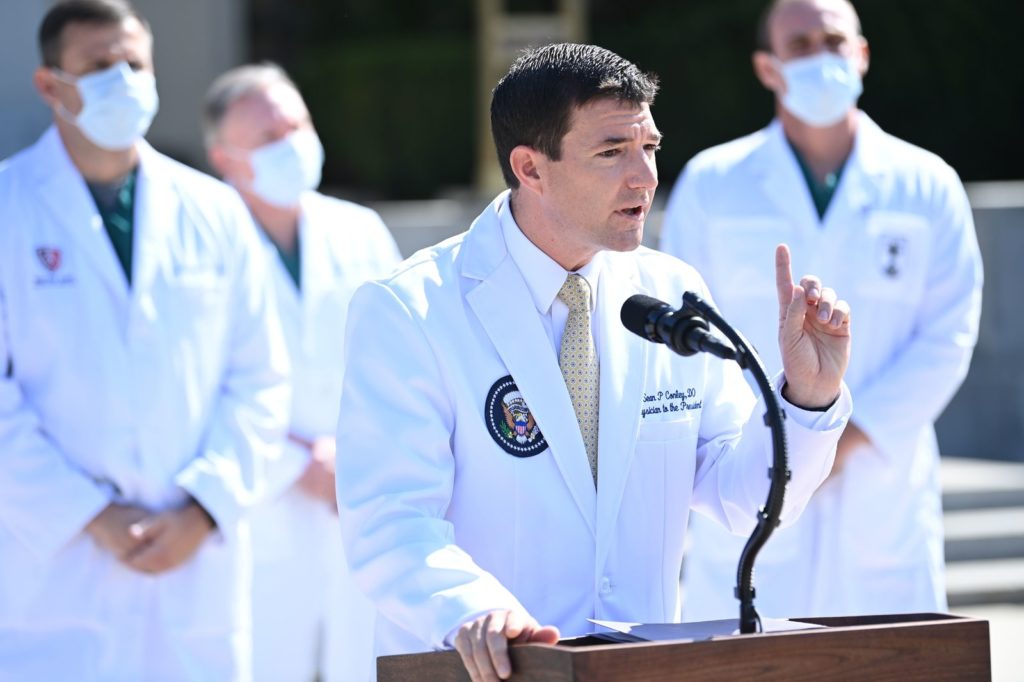
Doctors Say President Trump Being Treated With Antiviral, Steroid; Could Leave Hospital Monday
BY BARBARA SPRUNT
President Trump has experienced two drops in his oxygen levels over the course of his COVID-19 diagnosis, and is now also being treated with a steroid, but could be discharged from Walter Reed National Military Medical Center as early as Monday, his physicians told reporters during a briefing Sunday.
Trump was admitted to Walter Reed Friday evening after announcing early that morning that he and the first lady had tested positive for the coronavirus.
“Since we spoke last [on Saturday], the president has continued to improve,” the president’s physician, Sean Conley, said. “As with any illness, there are frequent ups and downs, particularly when a patient is being so closely watched 24 hours a day.”

White House physician Sean Conley updates the press on the health status of President Trump on Sunday, Oct. 4.
CREDIT: Brendan Smialowski/AFP via Getty Images
Conley said that Trump had a high fever and saw his oxygen levels fall while at the White House on Friday morning ahead of being moved to Walter Reed. He did not detail Trump’s high temperature.
“Given these two developments, I was concerned for possible progression of the illness,” Conley said. “I recommended [to] the president we try some supplemental oxygen, see how he’d respond. He was fairly adamant that he didn’t need it. He was not short of breath; he was tired, had the fever, and that was about it. After about a minute on only two liters, his saturation levels were back over 95%. He stayed on that for about an hour.”
Trump experienced a second episode of falling oxygen levels Saturday, dropping to 93%, Conley said. He said he didn’t know whether Trump received supplemental oxygen at that point. “I’d have to check with the nursing staff,” he said.
When asked whether any signs of pneumonia are apparent on the president’s X-rays and scans, Conley said, “There’s some expected findings but nothing of any major clinical concern.”
Trump also received his first dose of the steroid dexamethasone Saturday, with Conley saying the potential benefits of the treatment outweigh the risks.
Trump’s care plan includes a five-day treatment course of remdesivir, which Dr. Brian Garibaldi said Trump “tolerated well.”
“If he continues to look and feel as well as he does today our hope is that we can plan for a discharge as early as tomorrow to the White House where he can continue his treatment course,” Garibaldi said.
A similar news conference Saturday led to many questions.
The timeline Conley presented to reporters of Trump’s diagnosis was quickly walked back by the White House.
And though Conley said Trump’s symptoms were improving and that he was “extremely happy” with the progress being made, almost immediately after the briefing, a White House official — later identified by The Associated Press as White House chief of staff Mark Meadows — contradicted Conley, telling reporters: “The president’s vitals over the last 24 hours were very concerning and the next 48 hours will be critical in terms of his care. We’re still not on a clear path to a full recovery.”
On Sunday, Conley said the chief of staff’s statement was “misconstrued.”
“What he meant was that 24 hours ago, when he and I were checking on the president, that there was that momentary episode of the high fever and that temporary drop in the saturation, which prompted us to act expediently to move him up here,” Conley said.
When asked why he was reluctant during Saturday’s briefing to disclose that Trump had been administered oxygen, Conley said he was trying to “reflect the upbeat attitude” of the medical team and the president.
“I didn’t want to give any information that might steer the course of illness in another direction,” he said. “And in doing so, you know, it came off that we’re trying to hide something, which wasn’t necessarily true. The matter is, is that [Trump’s] doing really well.”
The president himself tweeted a video Saturday evening, in which he said: “I came here, wasn’t feeling so well. I feel much better now.”
But echoing Meadows, Trump added: “You don’t know, over the next period of a few days, I guess that’s the real test, so we’ll be seeing what happens over those … next couple of days.”
— Donald J. Trump (@realDonaldTrump) October 3, 2020
Copyright 2020 NPR. To see more, visit npr.org















